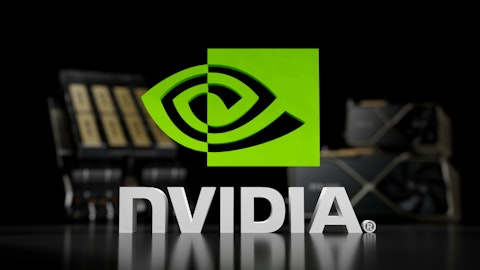Burke Wealth Management, an investment management company, released its “Focused Growth Strategy” second-quarter 2025 investor letter. A copy of the letter can be downloaded here. The second quarter was marked by significant volatility. Against this backdrop, the strategy returned +15.9% in the quarter compared to +10.9% for the S&P 500 Index. In addition, please check the fund’s top five holdings to know its best picks in 2025.
In its second-quarter 2025 investor letter, Burke Wealth Management highlighted stocks such as NVIDIA Corporation (NASDAQ:NVDA). NVIDIA Corporation (NASDAQ:NVDA) offers graphics and compute, and networking solutions. The one-month return of NVIDIA Corporation (NASDAQ:NVDA) was 0.70%, and its shares gained 40.75% of their value over the last 52 weeks. On August 22, 2025, NVIDIA Corporation (NASDAQ:NVDA) stock closed at $177.99 per share, with a market capitalization of $4.341 trillion.
Burke Wealth Management stated the following regarding NVIDIA Corporation (NASDAQ:NVDA) in its second quarter 2025 investor letter:
“NVIDIA Corporation (NASDAQ:NVDA): Shares of Nvidia were up 46% during the second quarter. Obviously, that is an outstanding result but in no way does it fully reflect the fundamental roller coaster ride the company was on during Q2. For the first time since the AI revolution began, Nvidia faced a threat to its dominant position. Frustratingly, this threat was not from a company with a competing technology but instead came from the United States government. A lot of attention has been given to the actions taken by the Biden administration during President Biden’s final days in office. While most of the scrutiny has focused on the wave of last minute pardons that were granted, the executive order on AI diffusion that was issued a week before the end of his term was what demanded our attention. This 200 page regulatory disaster would have placed restrictions on access to Nvidia chips to all but 18 countries in the world, with several NATO allies and the entirety of the Middle East among the impacted. If Xi Jinping and the CEO of Huawei had locked themselves in a room and tried to craft a piece of regulation that would guarantee Chinese dominance in AI for a generation they would have been hard pressed to come up with something better than the AI diffusion rules. If implemented, the AI diffusion rules would have resulted in the world building its AI infrastructure on the Huawei platform which China would have been more than happy to make readily available to any interested nation, rather than on Nvidia’s platform.
The idea that AI technologies can be controlled by the US government and exported to the rest of the world only after the completion of a nebulous regulatory maze is both arrogant and naïve. Roughly half of the world’s AI researchers are Chinese. China is going to have competitive AI capabilities. Artificial intelligence is not a race with a defined finish line and therefore AI leadership is going to be maintained by empowering our technology leaders (Nvidia) to run faster rather than trying to slow the pace of development in rival nations. Luckily, the AI diffusion rules crafted in January were not slated to take effect May 13th, which gave the Trump administration the chance to stop them which they did, almost. The Trump administration rescinded the AI diffusion rule which was greeted almost immediately by the announcement of a $50B AI factory being built on Nvidia chips in the UAE. This was a huge development as Huawei was beginning to make inroads across the Middle East with its technologically inferior, yet generally available products. Unfortunately, the lifting of the AI diffusion rules did not extend to China and the Trump administration moved the existing Chinese chip rules which restricted Chinese access to a degraded product (H-20) into an outright ban. The immediate implication of this was that Nvidia took a $5B write-down and left about $8B of Q2 revenues from China on the table. The longer-term implication is that the US government has just gifted Huawei a monopoly position in China while simultaneously stopping Nvidia from dominating China’s $50B and growing AI market for the foreseeable future. While there is still a chance that Nvidia chip access will be included in a broader trade deal with China and there is continued pressure to reverse this ban, at the present time we are headed for a world where certain parts of the world will build their AI infrastructure on a Chinese platform while the rest of the world will build on the Nvidia platform.”

A close-up of a colorful high-end graphics card being plugged in to a gaming computer.
NVIDIA Corporation (NASDAQ:NVDA) is in 5th position on our list of 30 Most Popular Stocks Among Hedge Funds. As per our database, 235 hedge fund portfolios held NVIDIA Corporation (NASDAQ:NVDA) at the end of the second quarter, which was 212 in the previous quarter. NVIDIA Corporation (NASDAQ:NVDA) reported another record quarter in the fiscal first quarter of 2026 with $44 billion in revenues, representing a 69% year-over-year increase. While we acknowledge the risk and potential of NVIDIA Corporation (NASDAQ:NVDA) as an investment, our conviction lies in the belief that some AI stocks hold greater promise for delivering higher returns and doing so within a shorter time frame. If you are looking for an AI stock that is more promising than NVIDIA Corporation (NASDAQ:NVDA) and that has 10,000% upside potential, check out our report about this cheapest AI stock.
In another article, we covered NVIDIA Corporation (NASDAQ:NVDA) and shared the list of best stocks to invest in for long term growth. In addition, please check out our hedge fund investor letters Q2 2025 page for more investor letters from hedge funds and other leading investors.
READ NEXT: The Best and Worst Dow Stocks for the Next 12 Months and 10 Unstoppable Stocks That Could Double Your Money.
Disclosure: None. This article is originally published at Insider Monkey.





